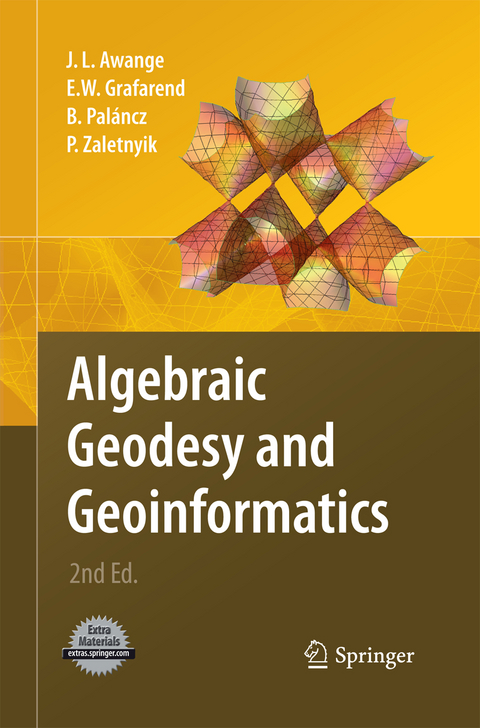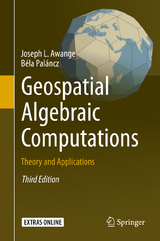
Algebraic Geodesy and Geoinformatics
Springer Berlin (Verlag)
978-3-642-43113-5 (ISBN)
While preparing and teaching 'Introduction to Geodesy I and II' to undergraduate students at Stuttgart University, we noticed a gap which motivated the writing of the present book: Almost every topic that we taught required some skills in algebra, and in particular, computer algebra! From positioning to transformation problems inherent in geodesy and geoinformatics, knowledge of algebra and application of computer algebra software were required. In preparing this book therefore, we have attempted to put together basic concepts of abstract algebra which underpin the techniques for solving algebraic problems. Algebraic computational algorithms useful for solving problems which require exact solutions to nonlinear systems of equations are presented and tested on various problems. Though the present book focuses mainly on the two ?elds, the concepts and techniques presented herein are nonetheless applicable to other ?elds where algebraic computational problems might be encountered. In Engineering for example, network densi?cation and robotics apply resection and intersection techniques which require algebraic solutions. Solution of nonlinear systems of equations is an indispensable task in almost all geosciences such as geodesy, geoinformatics, geophysics (just to mention but a few) as well as robotics. These equations which require exact solutions underpin the operations of ranging, resection, intersection and other techniques that are normally used. Examples of problems that require exact solutions include; - three-dimensional resection problem for determining positions and orientation of sensors, e. g. , camera, theodolites, robots, scanners etc.
Algebraic symbolic and numeric methods.- Basics of ring theory.- Basics of polynomial theory.- Groebner basis.- Polynomial resultants.- Linear homotpy.- Solutions of Overdetermined Systems.- Extended Newton-Raphson method.- Procrustes solution.- Applications to geodesy and geoinformatics.- LPS-GNSS orientations and vertical deflections.- Cartesian to ellipsoidal mapping.- Positioning by ranging.- Positioning by resection methods.- Positioning by intersection methods.- GNSS environmental monitoring.- Algebraic diagnosis of outliers.- Datum transformation problems.
From the reviews of the second edition:
"I compliment the authors on this book because it brings together mathematical methods for the solution of multi-variable polynomial equations that are hardly covered side by side in any ordinary mathematical book: The book explains both algebraic ("exact") and numerical ("approximate") methods. It also points to the recent combination of algebraic and numerical methods ("hybrid" methods), which is currently one of the most promising directions in the area of computer mathematics. Prof. Dr.phil. Dr.h.c.mult. Bruno Buchberger, Professor of Computer Mathematics, and Head of Softwarepark Hagenberg. ... As the person responsible for Mathematica's GroebnerBasis and NSolve implementations, I am delighted to see them put to such practical use. It is, moreover, a pleasure to see methods from an abstract branch of mathematics come into play in attacking problems from a very important branch of technology." Daniel Lichtblau, Wolfram Research.
"The book consists of the two parts. In the first part, the authors give a review of some known results in linear algebra and numerical methods which are used in the second part. The second part is the basic in the book. ... Each theoretical statement given in the book is accompanied with many careful neat examples. A rich bibliography envelopes all basic directions in algebraic geodesy and geoinformatics." (I. V. Boikov, Zentralblatt MATH, Vol. 1197, 2010)
From the reviews of the second edition:“I compliment the authors on this book because it brings together mathematical methods for the solution of multi-variable polynomial equations that are hardly covered side by side in any ordinary mathematical book: The book explains both algebraic ("exact") and numerical ("approximate") methods. It also points to the recent combination of algebraic and numerical methods ("hybrid" methods), which is currently one of the most promising directions in the area of computer mathematics. Prof. Dr.phil. Dr.h.c.mult. Bruno Buchberger, Professor of Computer Mathematics, and Head of Softwarepark Hagenberg. … As the person responsible for Mathematica's GroebnerBasis and NSolve implementations, I am delighted to see them put to such practical use. It is, moreover, a pleasure to see methods from an abstract branch of mathematics come into play in attacking problems from a very important branch of technology.” Daniel Lichtblau, Wolfram Research.“The book consists of the two parts. In the first part, the authors give a review of some known results in linear algebra and numerical methods which are used in the second part. The second part is the basic in the book. … Each theoretical statement given in the book is accompanied with many careful neat examples. A rich bibliography envelopes all basic directions in algebraic geodesy and geoinformatics.” (I. V. Boikov, Zentralblatt MATH, Vol. 1197, 2010)
| Erscheint lt. Verlag | 23.11.2014 |
|---|---|
| Zusatzinfo | XVIII, 377 p. |
| Verlagsort | Berlin |
| Sprache | englisch |
| Maße | 155 x 235 mm |
| Gewicht | 605 g |
| Themenwelt | Mathematik / Informatik ► Mathematik ► Analysis |
| Naturwissenschaften ► Geowissenschaften ► Geografie / Kartografie | |
| Naturwissenschaften ► Geowissenschaften ► Geologie | |
| Schlagworte | algebraic computations • Computer Algebra • Engineering • Geodesy • geoinformatics • GIS • Photogrammetry • Robotics • Surveying |
| ISBN-10 | 3-642-43113-5 / 3642431135 |
| ISBN-13 | 978-3-642-43113-5 / 9783642431135 |
| Zustand | Neuware |
| Haben Sie eine Frage zum Produkt? |
aus dem Bereich



